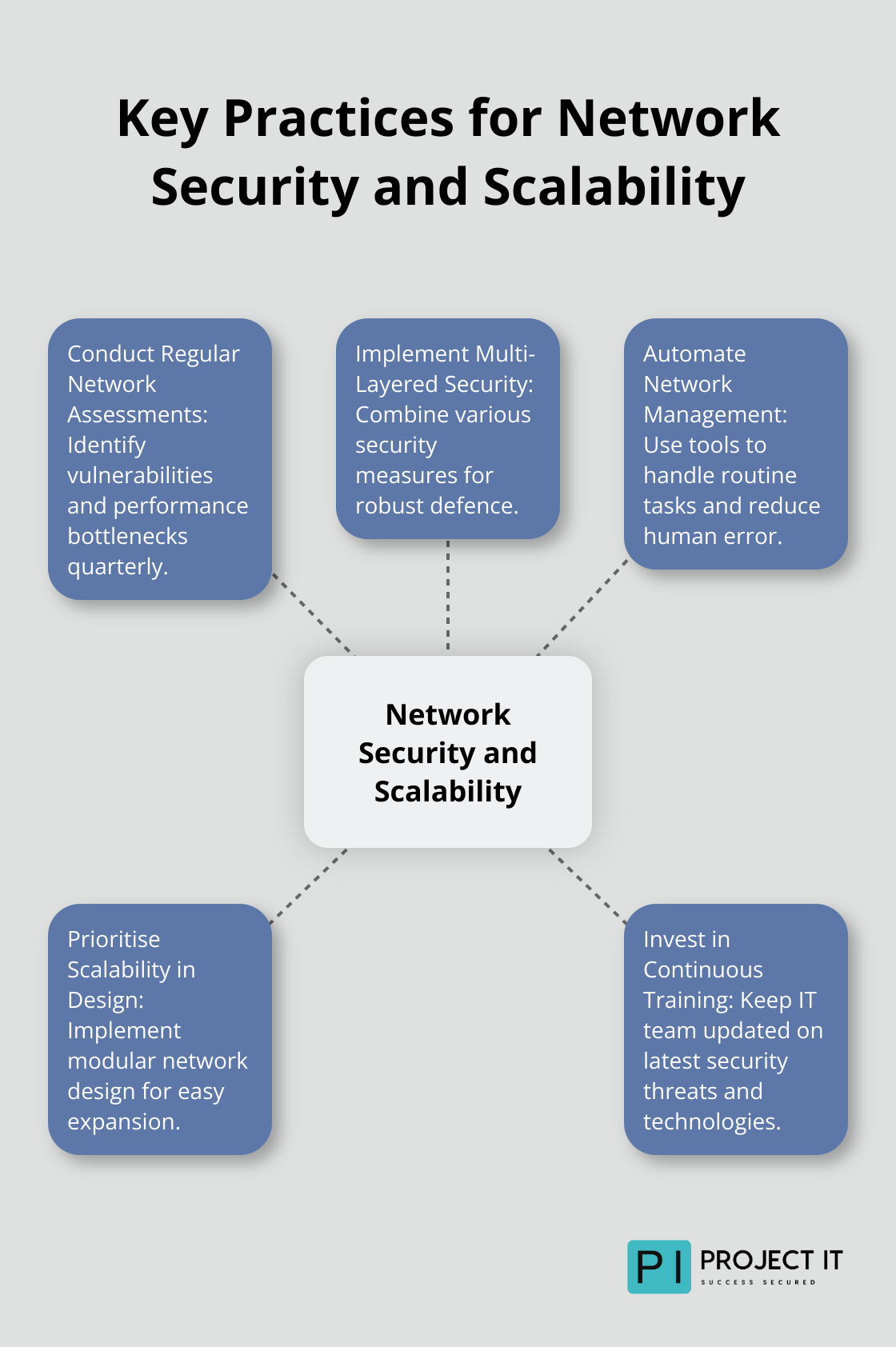At Project IT, we know that a robust network infrastructure is the backbone of any growing business.
As companies expand, their network needs evolve rapidly, demanding scalable solutions that can keep pace with increasing data traffic and user demands.
This blog post explores the key components and strategies for building a network infrastructure that can grow with your organisation, ensuring seamless operations and enhanced productivity.
What Makes a Network Infrastructure Scalable?
High-Performance Hardware: The Foundation of Scalability
The backbone of any scalable network is high-performance hardware. Switches and routers that handle increasing data loads are essential. Enterprise-grade switches with 10 Gbps ports are becoming standard for growing businesses. These devices manage current traffic and provide headroom for future expansion, offering ten times faster data transfer rates than 1 Gigabit switches.

Redundancy: Ensuring Uninterrupted Connectivity
One internet connection isn’t enough for a growing business. Multiple internet connections from different ISPs are necessary. This approach isn’t just about having a backup-it’s about load balancing and ensuring business continuity. A study by the Ponemon Institute found that the average cost of IT downtime is $5,600 per minute. Redundancy acts as a shield against such losses.
Cloud Integration: Flexibility and Scalability on Demand
Cloud-based services and storage are game-changers for scalability. They allow businesses to expand resources on-demand without significant hardware investments. Many companies that transition to cloud platforms (like Microsoft Azure or Amazon Web Services) see substantial benefits in cost reduction and increased scalability.
Virtualisation: Maximising Resource Efficiency
Virtualisation technologies maximise the efficiency of scalable networks. Creating virtual instances of servers, storage, and networking resources allows businesses to maximise hardware utilisation and scale up or down as needed. Virtualisation is key to business agility, allowing companies to adapt their scale quickly and easily without pouring money into physical infrastructure.
Network Management and Monitoring
Effective network management and monitoring tools are critical for maintaining a scalable infrastructure. These tools provide real-time insights into network performance, help identify bottlenecks, and allow for proactive problem-solving. Advanced network management solutions (such as SolarWinds or Cisco DNA Centre) can automate many routine tasks, freeing up IT staff to focus on strategic initiatives.
As we move forward, it’s important to consider how these components work together to create a truly scalable network. Let’s explore the strategies for designing such a network in the next section.
How to Design a Network for Future Growth
At Project IT, we’ve witnessed the importance of designing networks that can grow with your business. A well-designed scalable network doesn’t just meet today’s needs-it anticipates tomorrow’s challenges.
Embrace Modular Architecture
One of the most effective strategies for building a scalable network is to adopt a modular architecture. This approach allows you to add or upgrade components without overhauling the entire system. You might start with a core switch and add access switches as your business expands. This flexibility proves invaluable for growing businesses.
According to recent industry surveys, 78% of IT managers indicated that modular architectures significantly reduce long-term costs and downtime during updates. This reduction in downtime translates directly to improved productivity and cost savings.

Future-Proof Your Capacity
When you plan your network, look beyond your current needs. We recommend you overestimate your capacity requirements by at least 50%. This buffer ensures that your network can handle unexpected spikes in traffic or rapid business growth without requiring immediate upgrades.
Consider implementing 10 Gigabit Ethernet (10GbE) switches in your core network, even if your current needs don’t demand such high bandwidth. The cost difference between 1GbE and 10GbE has narrowed significantly, making it a wise investment for future-proofing your network.
Implement Smart Traffic Management
Load balancing and traffic management techniques are essential for maintaining network performance as your business grows. These technologies distribute network traffic across multiple paths and servers, preventing any single point from becoming a bottleneck.
For example, implementing a Layer 7 load balancer can improve application performance by intelligently routing requests based on content type, user location, or server load. This not only enhances user experience but also maximises the efficiency of your network resources.
Leverage Software-Defined Networking
Software-Defined Networking (SDN) revolutionises how we manage and scale networks. SDN separates the control plane from the data plane, allowing for more flexible and dynamic network management.
A recent study found that SDN offers significant benefits for cloud data centre management, including improved scalability, flexibility, and cost efficiency. These benefits make SDN a powerful tool for businesses looking to build scalable, efficient networks.
As we move forward, it’s important to consider how these design strategies work in tandem with best practices for network scalability and security. In the next section, we’ll explore these practices to ensure your network remains robust and secure as it grows.
How to Secure and Scale Your Network
At Project IT, we understand the importance of maintaining a secure and scalable network. As businesses grow, so do the challenges of managing and protecting IT infrastructure. Let’s explore key practices that will help you stay ahead of the curve.

Conduct Regular Network Assessments
Network assessments serve as your first line of defence against potential issues. We recommend thorough assessments at least quarterly. These evaluations help identify vulnerabilities, performance bottlenecks, and areas for improvement before they become critical problems.
Use tools like Nmap for network discovery and security auditing. Wireshark excels at deep packet inspection and network protocol analysis. These tools provide valuable insights into your network’s health and security posture.
Implement Multi-Layered Security
In today’s threat landscape, a single security solution doesn’t suffice. We advocate for a multi-layered approach that combines various security measures to create a robust defence system.
Start with a next-generation firewall (NGFW) that offers advanced threat protection. Palo Alto Networks and Fortinet lead in this space. Complement this with an Intrusion Detection and Prevention System (IDPS) to monitor network traffic for suspicious activity.
Implement strong encryption protocols for data in transit and at rest. Use AES-256 encryption for sensitive data and secure all communication channels with TLS 1.3 or higher.
Don’t overlook endpoint security. Deploy advanced endpoint protection solutions (like CrowdStrike or SentinelOne) on all devices connected to your network. These AI-driven tools can detect and respond to threats in real-time, significantly enhancing your overall security posture.
Automate Network Management
Automation plays a key role in managing a growing network efficiently. Network automation tools handle routine tasks, reduce human error, and free up your IT team to focus on strategic initiatives.
Consider network configuration management tools like Ansible or Puppet. These tools automate the process of configuring and updating network devices, ensuring consistency across your infrastructure.
For network monitoring and alerting, tools like Nagios or Zabbix automatically detect and notify you of issues before they impact your business operations.
Prioritise Scalability in Design
When designing your network, prioritise scalability from the outset. This approach allows for seamless growth without major overhauls.
Implement a modular network design that allows for easy expansion. Use scalable protocols like BGP for routing, which can handle large-scale networks efficiently.
Consider software-defined networking (SDN) solutions. SDN offers enhanced flexibility and agility, improved network automation, enhanced network security, increased network efficiency, and simplified network management.
Invest in Continuous Training
The technology landscape evolves rapidly. Invest in continuous training for your IT team to keep them updated on the latest security threats, network technologies, and best practices.
Encourage certifications like CCNA, CompTIA Network+, or CISSP. These certifications ensure your team has the skills to manage and secure complex, growing networks.
Regular training also helps your team stay ahead of emerging threats and new vulnerabilities, enhancing your overall security posture.
Final Thoughts
A scalable network infrastructure forms the backbone of successful businesses in today’s digital landscape. High-performance hardware, redundant connections, and cloud integration create a flexible and resilient foundation for growth. Proactive planning and management enable organisations to adapt their networks to changing needs without major overhauls.
Security remains a top priority as networks expand. Regular assessments, multi-layered security measures, and automated management tools protect growing infrastructures against evolving threats. Continuous training for IT teams ensures they stay prepared to tackle new challenges as they arise.
We at Project IT specialise in building and maintaining scalable, secure network infrastructures. Our expert team guides businesses through the process of creating networks that meet current needs and support future expansion. We offer comprehensive support (including IT consulting, managed services, and advanced security solutions) to ensure your network infrastructure drives innovation and enhances productivity.


